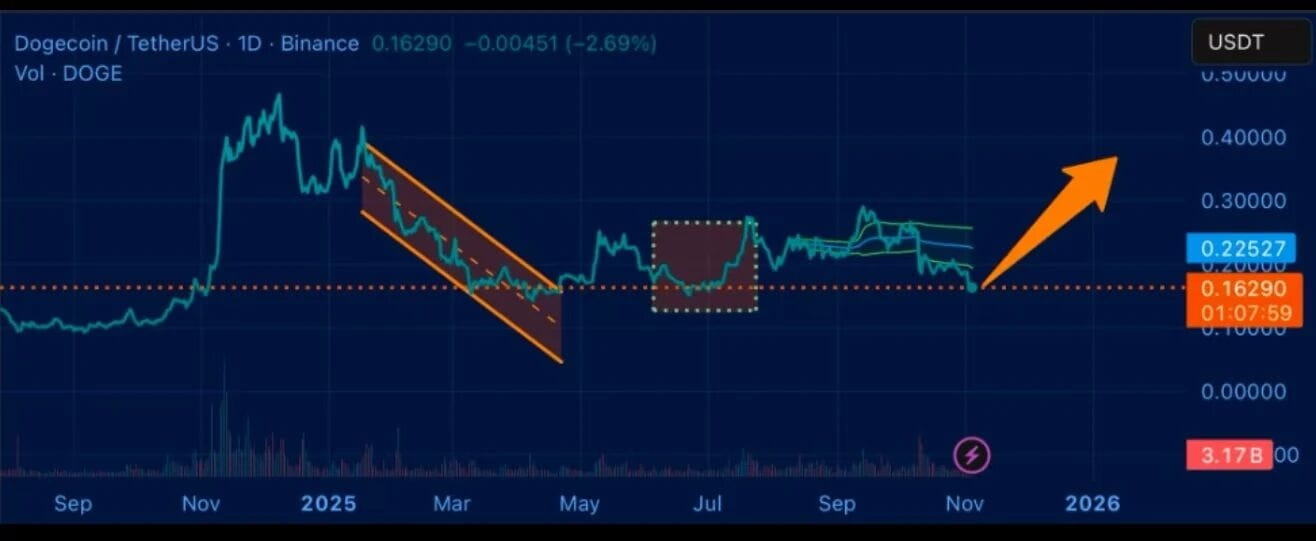This week, Musk left a brief message on social media - 'It’s time', and this tweet quickly ignited discussions about Dogecoin in the market. Traders acted on the news, seeking potential speculative opportunities in the Meme coin sector.
However, the price of Dogecoin (DOGE) itself reacts relatively slowly. Initially, there was no significant increase, and later it even followed the market downwards.

As of November 5th, DOGE had dropped to around $0.16. During the same period, Bitcoin and Ethereum also fell amid rising risk aversion, showing overall market weakness.
Funds are flowing into DOGE-1: on-chain speculators are active again.
It is worth noting that speculative enthusiasm has not diminished but has shifted to a meme token with the same name—DOGE-1.
Affected by Musk's posts, the price of DOGE-1 skyrocketed nearly 300% in a short time, although it later retraced about 17.4% to $0.73, it still became the focus of on-chain capital chasing.
On-chain monitoring platform data shows that the well-known trader god.sol (Mitch) has been very active during this period:
He bought 16.27 million DOGE-1 at a cost of about 100 SOL (approximately $14,800).
This address has extremely high activity, with historical cumulative profits exceeding $2.8 million, mainly from frequent trading of meme coins.

The DOGE-1 satellite mission is still progressing, expected to launch in 2025.
DOGE-1 is not just a meme token; it corresponds to a real space program.
The project is promoted by Geometric Energy Corporation and plans to launch a cube satellite via SpaceX's Falcon 9 rocket. Part of the mission funding is paid in Dogecoin, symbolizing the first attempt of cryptocurrency to fund a space mission.
Despite multiple delays, the new target launch time is set for the end of 2025.
The Musk effect is weakening, and the market attitude is becoming more rational.
Although Musk has deep ties with Dogecoin—he once called it 'the people's cryptocurrency,' changed his profile to 'former CEO of Dogecoin,' and in 2021 alone pushed DOGE's market value to $80 billion with his personal influence—this time, the market's reaction is clearly more rational.
Since October, the cryptocurrency market has continued to be under pressure and remains sluggish in early November.
Large-scale liquidations and liquidity tightening make it difficult for the past script of 'Musk shouts, coin flies' to be repeated.
Bitcoin's daily decline once reached 10%, and traders generally shifted to a defensive stance. The rise lacks continuity, and the decline only attracts limited bottom-hunting, with rebound momentum clearly insufficient.
Technical aspect: DOGE is stabilizing in the short term, but the trend remains bearish.
Dogecoin experienced a rapid decline, and a 'V-shaped rebound' pattern appeared in the short-term charts, but the rebound did not break through.
The price has fallen below $0.1620 and is stuck in consolidation, with short-term resistance still strong. Although there are signs of stabilization at the end of the trading session, the volume structure indicates that selling pressure still dominates the market.
From the trend structure, DOGE is still in a downward channel of 'lower lows, lower highs.'

The last oversold rebound looked more like a typical technical correction, with a rhythm similar to the 'crash-stop' pattern during the distribution phase.
The hourly momentum indicator remains negative, and the daily RSI is still stuck below 40 in the weak range.
To break the downward trend, it must continue to hold above $0.1650.
The key short-term support level is in the range of $0.1550–$0.1555. If it fails to hold, it may test the liquidity pool at $0.1520–$0.1500 below.
For the rebound to establish effective stabilization, it needs to reclaim $0.1630–$0.1650 and challenge the resistance at $0.1690 again.
Overall, it is still a typical distribution structure, and the rebound strength is limited.
The strategy should primarily be to wait and see, judging the direction after a breakthrough at key price levels.


